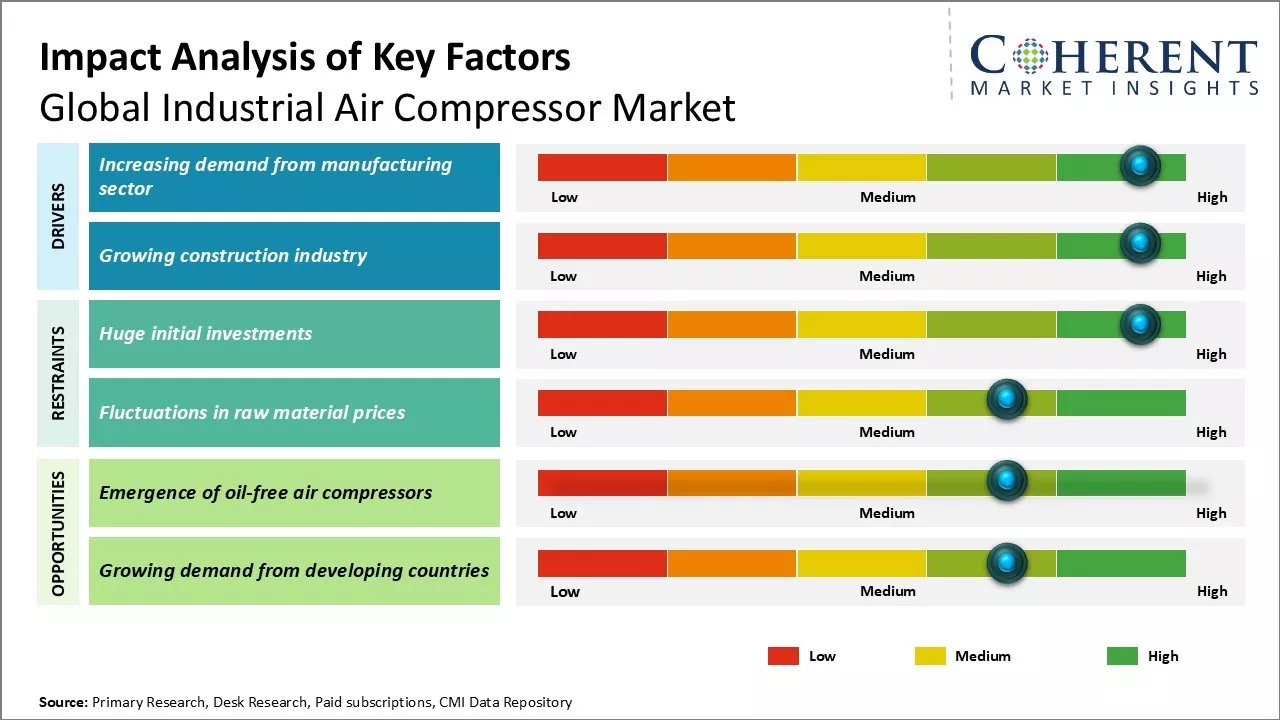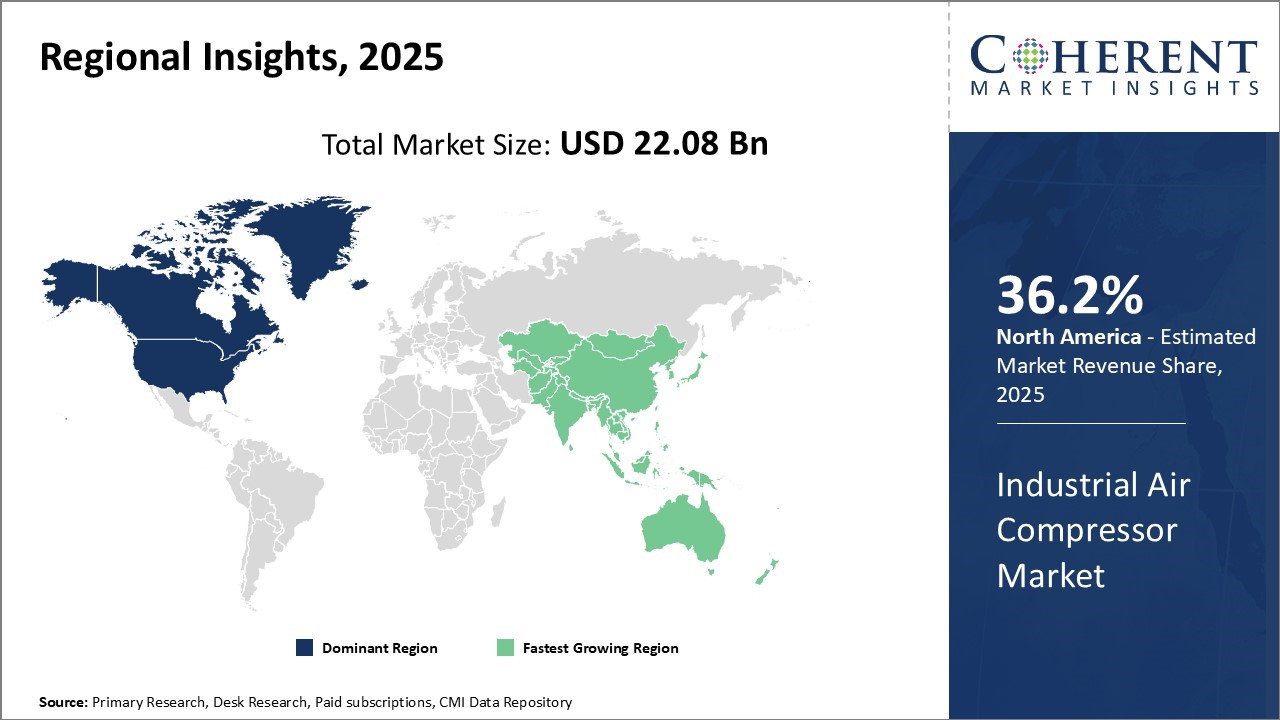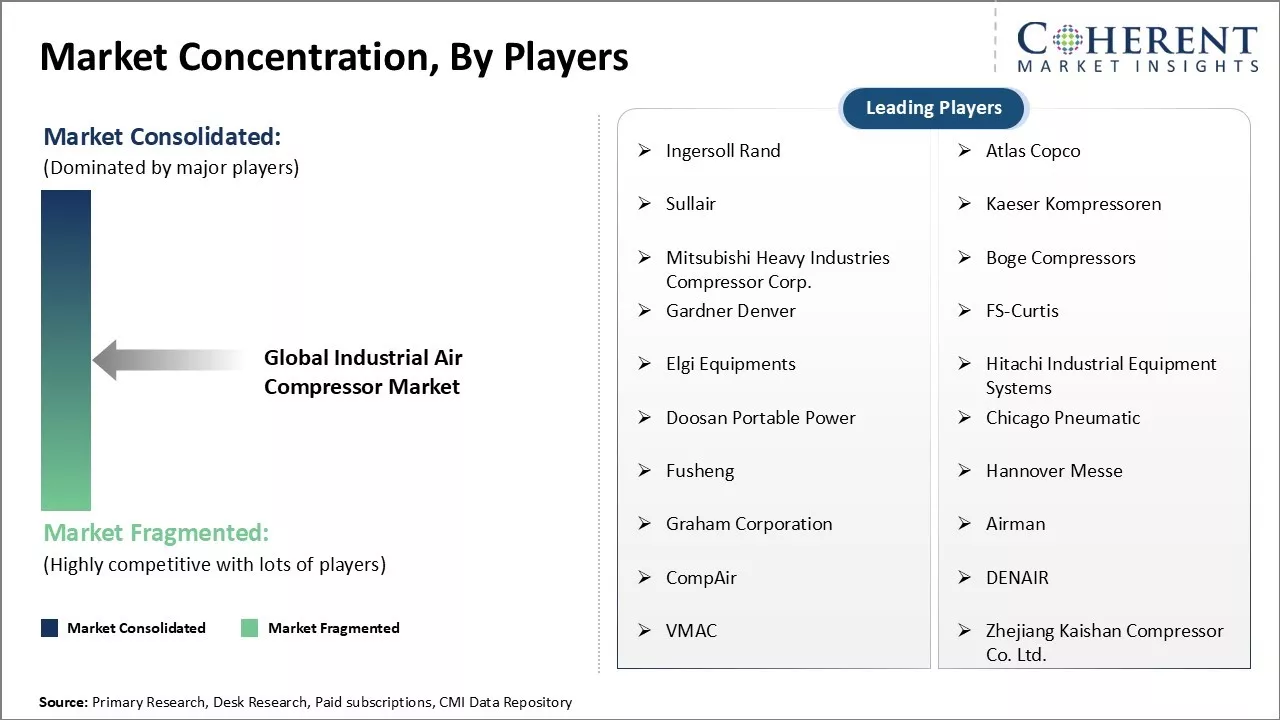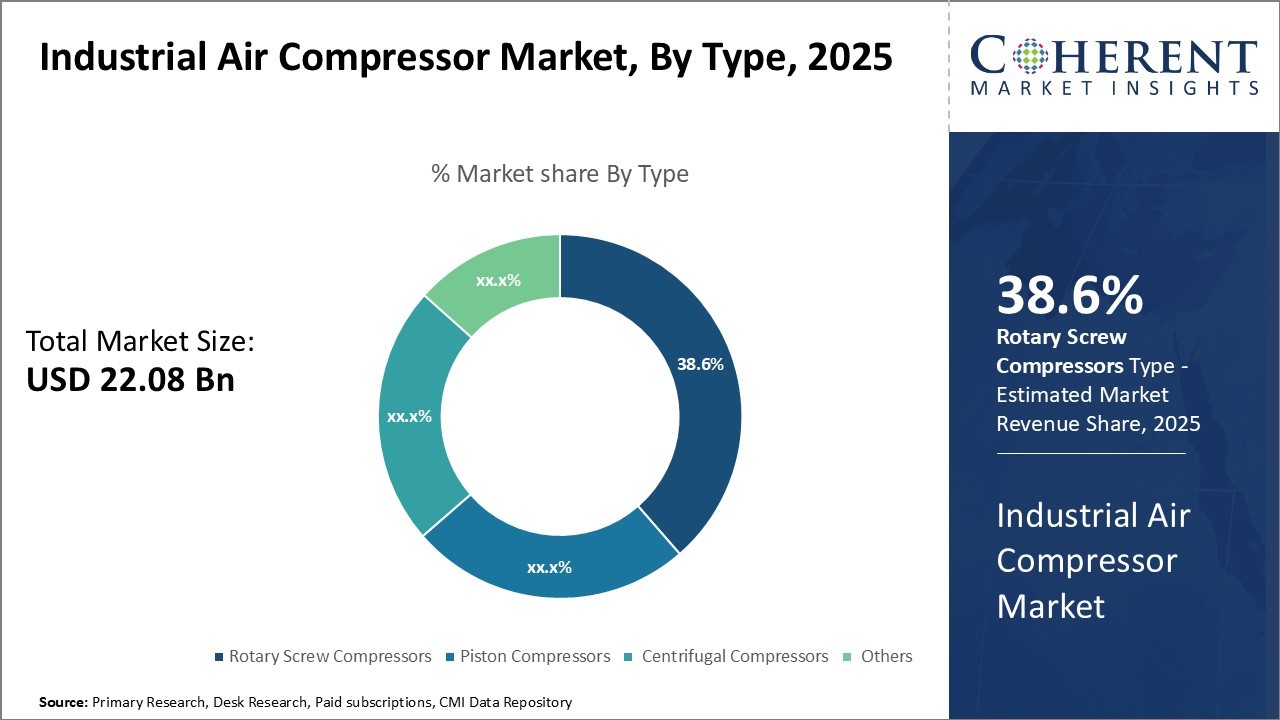Industrial Air Compressor Market Size and Forecast – 2025 to 2032
The global industrial air compressor market is estimated to be valued at USD 22.08 Bn 2025 and is expected to reach USD 30.89 Bn by 2032, exhibiting a compound annual growth rate (CAGR) of 4.9% from 2025 to 2032.
Key Takeaways
- By Type, Rotary Screw compressors are expected to contribute 38. 6%share of the market in 2025 owing to its electrification & energy efficiency.
- By Application, Manufacturing is expected to contribute 39. 1%share of the market in 2025 owing to its energy efficiency & sustainability pressures.
- By Region, North America acquired the prominent market share of 36.2% in 2025 owing to the increased infrastructure investment.

To learn more about this report, Download Free Sample
Market Overview
The industrial air compressor market is witnessing strong growth driven by factors such as rapid industrialization and ongoing infrastructural developments across the globe. The market is gaining from increasing applications of compressed air across industries such as manufacturing, oil & gas, construction, and others. Compressed air finds wide usage for applications such as pneumatic applications, cooling & drying, and pressure applications among others. Growing prominence of industrial automation along with ongoing adoption of Industry 4.0 technologies across manufacturing facilities is creating a conducive environment for market growth. Various technological advancements such as the integration of IoT and AI aimed at enhancing efficiency are expected to present new avenues of growth for industrial air compressor vendors over the coming years.
Current Events and their Impact on the Industrial Air Compressor Market
|
Current Events |
Description and its impact |
|
Geopolitical Tensions and Trade Policies |
|
|
Supply Chain and Raw Material Volatility |
|
|
Regional Industrial Demand Shifts |
|
Uncover macros and micros vetted on 75+ parameters: Get instant access to report
End-user Feedback and Unmet Needs in the Industrial Air Compressor Market
- Demand for Energy Efficiency and Cost Savings: End-users consistently seek compressors that reduce energy consumption to lower operational costs. Many report that existing models still consume excessive power, and they desire more affordable, energy-efficient solutions with better performance in varying load conditions.
- Need for Reliable, Low-Maintenance Equipment: Users emphasize the importance of compressors requiring minimal maintenance and offering longer service life. Frequent breakdowns and complex servicing remain challenges, prompting demand for robust, easy-to-maintain designs and improved predictive maintenance features.
- Preference for Noise Reduction and Compact Designs: Industrial operators highlight noise pollution as a key concern, especially in indoor and urban settings. They require quieter compressor units with smaller footprints to fit limited space without compromising capacity, ensuring safer and more comfortable work environments.
Market Price Ranges
Based on various sources, industrial air compressor costs substantially vary depending on type and capacity:
- Reciprocating (5 HP): ₹110,000–₹275,000 (USD 1,500–2,500)
- Rotary screw (5–30 HP): ₹180,000–₹640,000 (USD 2,500–8,000)
- Rotary screw (30–100 HP): ₹640,000–₹2 million (USD 8,000–25,000)
- Large industrial (100+ HP):
- 100 HP: ₹1.6M–₹2.8M (USD 20–35k)
- 200 HP: ₹3.2M–₹5.6M (USD 40–70k)
Hidden costs to include in budgeting: installation (₹40k–₹160k+), piping, electrical setup, air dryers/filters (₹80k–₹1.6M), plus ongoing energy (~65–90% of total life‑cycle cost), maintenance (5–12%), and depreciation.
Industrial Air Compressor Market Insights, By Type
Rotary Screw compressors contribute the highest share of the market owing to its remote & mobile needs
Rotary screw compressors are expected to contribute 38.6% share of the market in 2025. Rotary screw compressors dominate the industrial air compressor market owing to their robust construction and versatility across industries. These compressors have almost completely replaced older technologies due to their reliability and efficiency. Rotary screw compressors employ two meshing rotors to compress air through the reduction of volume in pockets formed between the rotors and the casing. Multiple sealing points provide leakage-free compression. Their construction using precision-machined rotors allows for a consistent and reliable air supply critical to manufacturing processes.
For instance, Atlas Copco has launched the GA VSDS, its most advanced and energy-efficient rotary screw compressor. As the third generation of variable speed drive (VSD) compressors, it intelligently adjusts motor speed to match air demand, significantly cutting energy use.
Industrial Air Compressor Market Insights, By Application
Manufacturing contributes the highest share of the market owing to its global supply chain optimization
Manufacturing is expected to contribute 39.1% share of the market in 2025. The manufacturing industry relies heavily on compressed air for pneumatic tools, assembly lines, and process applications. Precision and consistency in operations require a stable and regulated supply of compressed air. Quality control through leak detection, product testing, and surface treatment are integral to modern manufacturing workflows. Compressed air-based leak detection allows for pinpointing air leaks in complex assemblies, critical for industries such as automobiles with stringent emission standards.
In February 2025, Elgi Equipments, a global manufacturer of air compressors, launched its new "Stabilisor" technology to boost the efficiency and lifespan of air compressors in facilities with fluctuating air demand. This system tackles the issues caused by frequent load/unload cycles and offers a more effective solution than conventional methods.
Regional Insights

To learn more about this report, Download Free Sample
North America Industrial Air Compressor Market Trends
Investments in infrastructure, energy-efficiency regulations, and modern manufacturing trends are rapidly expanding the industrial air compressor market in North America. Key industries such as automotive, oil and gas, construction, and food processing are driving demand for smart compressors with variable-speed motors and oil-free designs to meet strict environmental and quality standards. Major OEMs like Atlas Copco, Ingersoll Rand, Kaeser, and Sullair are leading the way by developing integrated air utility systems, compact compressor designs, and predictive diagnostic technologies. For instance, in April 2025, South-Tek Systems, based in Wilmington, recently launched a new product line of compressed air equipment, featuring compressors, dryers, and filters.
Asia Pacific Industrial Air Compressor Market Trends
Southeast Asian countries, along with China and India, are actively investing in construction, manufacturing, and oil and gas sectors. This rapid industrial growth is increasing demand for reliable air compression systems in industries such as mining and automotive. In response to rising energy costs and environmental regulations, manufacturers are launching oil-free compressors and variable-speed drives (VSD) to reduce emissions and improve energy efficiency in industrial, HVAC, and refrigeration applications. For instance, in March 2023, BOGE launched its new S-4 series screw compressors in the 45 to 75 kW performance range in 2025, offering customers a range of advantages—from efficient, quiet, and reliable operation to easier maintenance. This is further accelerating the industrial air compressor market demand.
United States Industrial Air Compressor Market Trends
Manufacturers are responding to customer demand and regulatory pressures by developing energy-efficient compressors that are quieter and more compact. They are driving innovation in electric, oil-free rotary-screw models suited for indoor and sensitive environments, encouraged by consumer interest in space-saving designs and clean equipment incentives. Key industries such as heavy manufacturing, mining, oil and gas, and automotive are increasingly using stationary compressors for drilling, painting, and assembly operations. For instance, in August 2024, Kaishan USA, a global leader in industrial air compressors, has granted exclusive access to its new KROF series of oil-free rotary screw air compressors to food and beverage manufacturers.
India Industrial Air Compressor Market Trends
Indian enterprises are actively seeking energy-efficient, oil-free compressors to cut operating costs and meet environmental regulations. Manufacturers are delivering clean, efficient performance through advancements in oil-free screw compressors and variable-speed drives. Government and corporate incentives, such as energy efficiency programs, are accelerating adoption in pharmaceuticals, food processing, and electronics. At the same time, manufacturers are equipping compressor systems with IoT sensors, cloud-based analytics, and real-time diagnostics to enable energy optimization, leak detection, and predictive maintenance across widely distributed units.
For instance, in March 2025, Atlas Copco Group opened a new 270,000 sq. ft. manufacturing facility in Talegaon, Pune. The plant will manufacture air and gas compressors—including CNG, biogas, and hydrogen compressors—as well as air dryers, nitrogen and oxygen generators, and medical filtration accessories, further propelling the industrial air compressor market share.
Market Concentration and Competitive Landscape

To learn more about this report, Download Free Sample
Industrial Air Compressor Market News
- In July 2024, Atlas Copco introduced the X-Air⁺ 1200-25, a portable air compressor built for deep drilling in the construction, mining, and energy sectors. This new model reduces job completion time by at least 10 percent compared to its predecessor.
- In February 2025, Atlas Copco is setting the pace in the smart compressor market. With its new generation of GA 55+-75+ models, the company is delivering intelligent performance to the mid-size, fixed-speed industrial compressor segment, raising the bar for energy efficiency, reliability, and connectivity.
- In June 2024, WOLFBOX, a well-known name in the automotive electronics market, unveiled its new product line by launching the MegaFlow24 Pro air compressor. This portable tire inflator delivers ultra-fast inflation for vehicles of all sizes, as well as for motorcycles, bicycles, and sports balls.
- In March 2024, Hodge Compressor, a trailblazer in rotary screw air compressor manufacturing, launched its groundbreaking virtual reality product, the VR Showroom. With this launch, Hodge introduces the world’s first fully immersive virtual reality demonstration of a rotary screw air compressor.
Market Report Scope
Industrial Air Compressor Market Report Coverage
| Report Coverage | Details | ||
|---|---|---|---|
| Base Year: | 2024 | Market Size in 2025: | USD 22.08 Bn |
| Historical Data for: | 2020 To 2024 | Forecast Period: | 2025 To 2032 |
| Forecast Period 2025 to 2032 CAGR: | 4.9% | 2032 Value Projection: | USD 30.89 Bn |
| Geographies covered: |
|
||
| Segments covered: |
|
||
| Companies covered: |
Ingersoll Rand, Atlas Copco, Sullair, Kaeser Kompressoren, Mitsubishi Heavy Industries Compressor Corp., Boge Compressors, Gardner Denver, FS-Curtis, Elgi Equipments, Hitachi Industrial Equipment Systems, Doosan Portable Power, Chicago Pneumatic, Fusheng, Hannover Messe, Graham Corporation, Airman, CompAir, DENAIR, VMAC, and Zhejiang Kaishan Compressor Co. Ltd. |
||
| Growth Drivers: |
|
||
| Restraints & Challenges: |
|
||
Uncover macros and micros vetted on 75+ parameters: Get instant access to report
Industrial Air Compressor Market Trend
Growing Demand for Energy-Efficient Compressors
Industries are increasingly prioritizing energy efficiency to reduce operational costs and comply with environmental regulations. This trend drives the development and adoption of compressors equipped with variable-speed drives, oil-free technologies, and advanced control systems. Manufacturers are innovating to produce compressors that optimize power consumption based on real-time demand, minimizing wastage and boosting sustainability. Energy-efficient compressors not only lower utility bills but also help industries meet stricter emission norms, making them highly attractive across sectors.
Integration of Smart and IoT-Enabled Technologies
The industrial air compressor market is embracing Industry 4.0 by integrating IoT sensors, cloud computing, and AI-driven analytics. In September 2023, Elgi Equipments introduced Air~Alert to the Indian market—an IoT-enabled air compressor monitoring system. This service transmits data and analyzes key performance metrics, providing users with real-time alerts and actionable insights. These technologies enable real-time monitoring, predictive maintenance, and remote diagnostics, enhancing reliability and uptime. Smart compressors provide detailed performance insights that allow for proactive troubleshooting and optimized energy use. This digital transformation helps reduce maintenance costs and operational disruptions, driving greater adoption of connected, intelligent compressor systems in manufacturing, oil & gas, and other industrial sectors.
Industrial Air Compressor Market Opportunity
Expansion in Renewable Energy and Sustainable Industries
The growth of renewable energy sectors such as solar and wind power presents a significant opportunity for industrial air compressors. These industries require efficient, reliable compressed air systems for manufacturing, maintenance, and operational processes. As sustainability becomes a priority, manufacturers can develop eco-friendly compressors that align with clean energy goals, tapping into new markets and supporting global efforts to reduce carbon footprints. This is further propelling the industrial air compressor market revenue.
Analyst Opinion (Expert Opinion)
- The Industrial Air Compressor market is undeniably at a pivotal juncture, driven not just by incremental innovation but by fundamental shifts in operational priorities. In my view, the surge toward energy-efficient and digitally connected compressors is no longer optional but imperative. For instance, the adoption of variable-speed drives (VSD) in North America, where companies like Ingersoll Rand report up to 30% energy savings compared to traditional fixed-speed models. This shift reflects a broader industry consensus: energy costs and regulatory pressures are reshaping purchasing decisions with an unprecedented urgency.
- Moreover, the penetration of IoT and AI-powered predictive maintenance is not a futuristic ideal but an immediate necessity. Manufacturers who delay adopting these smart systems risk losing critical uptime and profitability. Atlas Copco’s implementation of their Connected Compressors platform showcases a reduction in unplanned downtime by approximately 25%, directly impacting clients’ bottom lines. The ability to diagnose faults remotely and schedule maintenance proactively is transforming asset management in ways previously unimaginable.
- Lastly, sustainability will no longer be a niche selling point but a baseline expectation. Regulatory frameworks in Europe and parts of Asia are progressively tightening, demanding zero-leak systems and clean energy integration. Compressors that fail to meet this evolving standards risk obsolescence. The transition to oil-free, low-emission compressors is accelerating, as evidenced by the rapid uptake in the food processing sector, where contamination risk and hygiene are paramount.
Market Segmentation
- Type Insights (Revenue, USD Bn, 2020 - 2032)
- Rotary Screw Compressors
- Piston Compressors
- Centrifugal Compressors
- Others
- Application Insights (Revenue, USD Bn, 2020 - 2032)
- Manufacturing
- Construction
- Automotive
- Oil & Gas
- Food & Beverage
- Others
- Regional Insights (Revenue, USD Bn, 2020 - 2032)
- North America
- U.S.
- Canada
- Latin America
- Brazil
- Argentina
- Mexico
- Rest of Latin America
- Europe
- Germany
- U.K.
- Spain
- France
- Italy
- Russia
- Rest of Europe
- Asia Pacific
- China
- India
- Japan
- Australia
- South Korea
- ASEAN
- Rest of Asia Pacific
- Middle East
- GCC Countries
- Israel
- Rest of Middle East
- Africa
- South Africa
- North Africa
- Central Africa
- Key Players Insights
- Ingersoll Rand
- Atlas Copco
- Sullair
- Kaeser Kompressoren
- Mitsubishi Heavy Industries Compressor Corp.
- Boge Compressors
- Gardner Denver
- FS-Curtis
- Elgi Equipments
- Hitachi Industrial Equipment Systems
- Doosan Portable Power
- Chicago Pneumatic
- Fusheng
- Hannover Messe
- Graham Corporation
- Airman
- CompAir
- DENAIR
- VMAC
- Zhejiang Kaishan Compressor Co. Ltd.
Sources
Primary Research Interviews
- Industry experts and senior executives from leading air compressor manufacturers
- Operations managers from automotive, manufacturing, and oil & gas companies
- Maintenance and facility managers in pharmaceuticals and food processing sectors
Databases
- U.S. Energy Information Administration (EIA)
- International Energy Agency (IEA)
- Global Trade Atlas
- National Bureau of Statistics of respective countries
Magazines
- CompressorTech2
- Plant Engineering
- Industrial Equipment News
- Air Compressor World
Journals’
- Journal of Manufacturing Science and Engineering
- IEEE Transactions on Industrial Electronics
- Energy Efficiency Journal
- Journal of Cleaner Production
Newspapers
- The Wall Street Journal – Industry Section
- Financial Times – Manufacturing and Energy
- The Economic Times – Industry & Infrastructure
- South China Morning Post – Business and Technology
Associations
- Compressed Air and Gas Institute (CAGI)
- Air Movement and Control Association International (AMCA)
- American Society of Mechanical Engineers (ASME)
- International Organization for Standardization (ISO)
Public Domain sources
- Government publications and whitepapers on energy efficiency and industrial equipment
- Patent filings related to compressor technology innovations
- Environmental Protection Agency (EPA) reports on industrial emissions
- Industry-specific technical standards and guidelines
Proprietary Elements
- CMI Data Analytics Tool, and Proprietary CMI Existing Repository of information for last 8 years
Share
Share
Missing comfort of reading report in your local language? Find your preferred language :
Transform your Strategy with Exclusive Trending Reports :
Frequently Asked Questions
EXISTING CLIENTELE
Joining thousands of companies around the world committed to making the Excellent Business Solutions.
View All Our Clients

